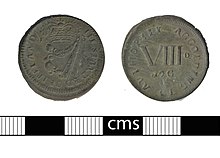| Pennyweight | |
|---|---|
 17th-century Irish weight, 8 dwt 17th-century Irish weight, 8 dwt | |
| General information | |
| Unit system | Troy weight |
| Unit of | Mass |
| Symbol | dwt |
| Conversions | |
| 1 dwt in ... | ... is equal to ... |
| Troy | 1⁄240 troy pound |
| Avoirdupois | 0.05485714 oz |
| SI units | 1.555174 g |

A pennyweight (dwt) is a unit of mass equal to 24 grains, 1⁄20 of a troy ounce, 1⁄240 of a troy pound, approximately 0.054857 avoirdupois ounce and exactly 1.55517384 grams. It is abbreviated dwt, d standing for denarius – (an ancient Roman coin), and later used as the symbol of an old British penny (see £sd).
History
In the Middle Ages, an English penny's weight was literally, as well as monetarily, 1⁄20 of an ounce and 1⁄240 of a pound of sterling silver. At that time, the pound unit in use in England was the Tower pound, equal to 7,680 Tower grains (also known as wheat grains). The medieval English pennyweight was thus equal to 32 Tower grains. When Troy weights replaced Tower weights in 1527, the Troy weights were defined in such a way that the old Tower pound came out to exactly 5,400 Troy grains (also known as barleycorns), the Tower pennyweight 22+1⁄2 Troy grains (and thus approximately 1.46 grams). After 1527, the English pennyweight was the Troy pennyweight. of 24 Troy grains. Thus the Troy pound, ounce, and pennyweight, with their definitions given in terms of the Troy grain instead of in terms of the Tower grain, were 1⁄15 or 6.667% more than the Tower equivalents.
Usage
The troy pound and the pennyweight lost their official status in the United Kingdom in the Weights and Measures Act of 1878; only the troy ounce and its decimal subdivisions remained official. The troy ounce enjoys a specific legal exemption from metrication in the UK.
The pennyweight is the common weight used in the valuation and measurement of precious metals. Jewellers use the pennyweight in calculating the amount and cost of precious metals used in fabricating or casting jewellery. Similarly, dentists and dental labs still use the pennyweight as the measure of precious metals in dental crowns and inlays.
Pennyweight and grains are still used to weigh gooseberries in competitions in Cheshire, northwest UK. Over the Pennines in Yorkshire the alternative drams and grains measurement has been used since a new set of scales was purchased by the Egton Bridge Old Gooseberry Society in 1937. As of 2018, the world record for the heaviest gooseberry of 41 dwt 11 gr (64.5 g) was held by Kelvin Archer of Cheshire.
The most common abbreviation for pennyweight is dwt; d, for the Roman denarius, was the abbreviation for penny before Decimalisation of the British monetary system. Alternate abbreviations are pwt and PW.
Uses unrelated to weight
Although the abbreviations are the same, the pennyweight bears no relation to the weight of the American penny nail. That name is derived from the price for a hundred nails in 15th century England: the larger the nail, the higher the cost per hundred. The pennyweight also bears no relation to the weight of the American "penny" (1 cent) coin, which weighs 2.5 g (for those minted after 1982).
Conversion
| 1 pennyweight | = 24 grains |
| = 1⁄20 Troy ounce | |
| = 1⁄240 Troy pound | |
| = 1.55517384 grams |
References
-
Calculated using the relationships:
- 1 avoirdupois ounce = 437.50 grains,
- 1 troy ounce = 480 grains.
-
Calculated using the relationship
- 1 troy grain = 0.06479891 gram (exact by definition).
- Zupko, Ronald Edward (1985). A dictionary of weights and measures for the British Isles. American Philosophical Society. pp. 280–84. ISBN 978-0-87169-168-2.
pennyweight.
- "Weights and Measures Act 1985". August 30, 2011. Retrieved September 22, 2011.
Part II Weighing and Measuring for Trade ... 8 Units of measurement, weights and measures lawful for use for trade ... (2) No person shall use for trade—(a) the ounce troy, except for the purposes of transactions in, or in articles made from, gold, silver or other precious metals, including transactions in gold or silver thread, lace or fringe...
- "Precious Metal Buyers, Gold Refiners, Gold Assayers, Waste Management". Precious metals calculator. Maguire & Strickland Refining. September 22, 2011. Retrieved September 22, 2011.
This section is for those in the trade. Those in the trade include jewellers, dentists and dental laboratories who have a store front, State ID numbers and Federal ID numbers ... We do not list a dental estimating factor as there is no standard gold percentage for dental solids
- "United Kingdom Guinness Records in 2013".
- "Penny" (subscription required). Oxford English Dictionary (2nd ed.). Retrieved 2010-05-30.
Applied to nails, such adjectives denote the original price (in 15th c.) per hundred; as fivepenny nail, a nail which cost 5d. a hundred, tenpenny nail, a nail costing 10d. a hundred. (These names persisted after the prices fell, as they began to do in some places before 1500, and they were eventually used to designate sizes of nails.)
- H. Littlehales (1905). Medieval Rec. London City ChurchCited in the Oxford English Dictionary under "Penny" with a quote from 1426-1427.
{{cite book}}: CS1 maint: postscript (link) - "Penny". sizes.com. Retrieved 2010-01-10.
- Norman Scott Brien Gras (1918). The Early English Customs System. Harvard University Press, Cambridge (MA). p. 701. Cited at sizes.com with a quote from 1507.
- "Coin Specifications" (table). About us. United States Mint. September 22, 2011. Retrieved September 22, 2011.
The following table gives specifications for The United States Mint legal tender coins presently in circulation